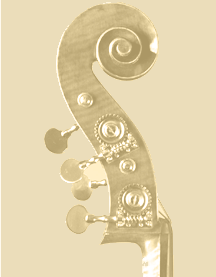Upright Bass Setup
Until now, we haven't made too big a deal about telling everyone
about our upright bass setups. We just took for granted that
everyone that got a bass from us, would always get the same great
attention and detail. Ok!, now we're sayin' it! Here we give a
detailed list of some of the things that we include in the set up of
our upright double basses:
1) fingerboards, are all solid ebony. Unless our customer
specifically asked for the old fashioned beveled fingerboard (the
type that has a high ridge down, along the A string) all of
our boards are rounded across. The camber that we plane is very
slight so that strings will not buzz, but vibrate freely and
minimize stress to the left hand. Those that want a deep
camber, no problem, we can do that too.
2) bridges are fitted perfectly to the top and for bridge
adjusters, we usually use the new high density, composite, 'delrin'
adjusters. These are much more expensive than any other bridge
adjuster, but they're worth it. They will never mute the bass
vibration and there is an absolute minimum of vibration interruption
when using these. We even use these in the setup on our
upright basses under $3k. These adjusters are also super
easy to use everyday and will not get hard to turn, or bind up
later.
3) the string height in our bass setup is a direct correlation of
how the fingerboard is planed and again, it' all about comfort.
Some really prefer a higher string. That's no problem, but
when the seasons change it's nice to re-adjust back to the preferred
playing height.
4) We set up all of our upright basses with "braided" steel cable.
We tried the special cords (like the Velvet strings brand) but
didn't like them because they stretched for days and weeks after
installing them. Each bass has an optimum cable length between
the bottom of the tailpiece, and the relationship and distance to
the bottom of the bass and endpin. Here, every bass is
different. Some like longer distances, some "like" shorter
distances on the cable. When we say "like", we mean whatever
allows the bass and strings to be the most responsive and vibrate
the free-est (is that a word?) Most of the time, we're able
to tune the strings, bridge and tailpiece so that the partials line
up in perfect 4th or 5th intervals between the open string and below
the bridge. Tricky, but we take the extra time to adjust
these.
5) No upright bass set up is complete, until the right sound post
is fitted to both the back and the top of the bass. This is
always more work as most of our basses (especially our new ones)
have carved backs, which always add another dimension to the sound
post adjustment. This is always an interesting part of the set
up: We always start in the middle of what most luthiers would
place a post, then we keep tweaking it until the bass comes alive.
One thing that we have found for sure is that every bass is
different and what works for one, will not always do the same for a
similar bass. That's why every note and every string has to be
played to check for notes that may stick out, or even wolf notes.
With patience, and trial and error you can find the optimum
placement for the sound post.
We take our upright bass setups very seriously. This is what
makes us the best. We're players here and we know what other
players need. We are always open and eager to accommodate any
individual's special need or request.
| |
 |
 |
|


